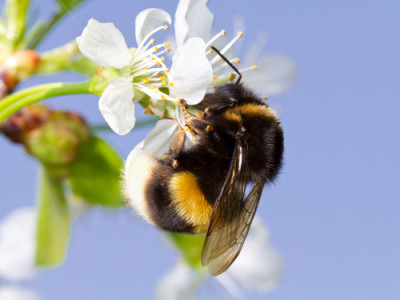Powerful Partnerships: Exploring Flowers and Their Pollinators
- July 17, 2014
- By Christy Peterson
 To make a prairie it takes a clover and one bee,
To make a prairie it takes a clover and one bee,
One clover and a bee,
And revery.
The revery alone will do,
If bees are few.
~Emily Dickinson
Take a walk through your flower garden. The astounding variation in colors, shapes, sizes, and smells comes to us courtesy of an ancient partnership, that of flowers and their pollinators. Flowers and pollination are subjects often found in elementary school science curricula. This article focuses on a unique aspect of this relationship—how specific flowers and specific pollinators have adapted to meet each other’s needs.
Plants Need Pollinators; Pollinators Need Plants
While some plants are self-pollinating or are pollinated by mechanical methods, like wind or water, most are pollinated by animals. The animals do not provide this service out of the goodness of their hearts. They are getting something in exchange—food, in the form of nectar and pollen. Plants advertise their need for pollinators using visual cues (shape and color) and smells. This “I help you, you help me” relationship is referred to in biology as “mutualism.”
Welcome! or Keep Out!
In order for mutualism to work, each party has to benefit from the actions of the other. If a plant provides little in the way of nectar or pollen, its flowers will not make it onto a pollinator’s route. If a pollinator sips nectar without transferring pollen from one flower to the other, the plant loses.
Over time, plants have developed structures to force pollinators to keep up their end of the bargain. For example, bottle gentian has large, tightly-closed flowers that exclude most pollinators. However, large bumblebees are strong enough to pry open the petals and crawl inside.
In return, pollinators have developed methods to get around these structures to exploit the flowers’ resources. Small worker bumblebees get around the bottle gentian flower’s “closed” sign by feeding through small holes chewed into the base of the flower.
Some flowers have developed such specialized relationships that they can only be pollinated by a single species. Cacao trees, from which we get chocolate, have tiny, complex flowers that can only be pollinated by a teeny midge fly. In Hawai’i, the scarlet i’iwi sips nectar with its curving beak out of lobelia flowers with the same curve. In Madagascar, Charles Darwin encountered an orchid that has an 11-inch deep flower. He reasoned there must be a pollinator with specialized equipment to feed from that flower, and sure enough, many years later, a moth with an 11-inch long proboscis was discovered.
Activity—Matching Flowers to Their Perfect Pollinator Partners
Such unique, specialized relationships are not common, but you and your students can explore everyday flowers and their pollinator partners with the following activity:
You’ll need:
- Parts of a flower diagram (you’ll find one here if needed: http://www.mundesleyjuniorschool.com/InternetResources/Science/Y5/LifeCycles/partsflower.jpg)
- a variety of flowers brought by students or teacher
- magnifying glasses (one per student would be great, but students can share if needed)
Review the parts of a flower, as appropriate for the age level of your students. Discuss the ways plants use their flowers to attract pollinators—shape, color, smell. Then look at each type of flower in your classroom sample and pose the following questions:
- What is the flowers color and shape?
- Does it have a smell?
- Can you find its parts? (Remember, some flowers are composite, meaning that they are really many tiny flowers packed into what looks like one flower.
- What physical features are needed by a pollinator partner for this particular flower? (long tongue or short, ability to hover, small body size, etc.)
Online Resources
- Pollinator Partnership has a substantial library of resources for educators: http://www.pollinator.org/education.htm
- The U.S. Forest Service has good information on pollination on its webpage: http://www.fs.fed.us/wildflowers/pollinators/index.shtml
- The U.S. Fish & Wildlife service also has pollinator information on its webpage: http://www.fws.gov/pollinators/
- TED offers a stunning video by Louie Schwartzberg about pollination (please preview before using in your classroom): http://www.ted.com/talks/louie_schwartzberg_the_hidden_beauty_of_pollination
- “Plants and Animals, Partners in Pollination,” from Smithsonian Education: http://www.smithsonianeducation.org/educators/lesson_plans/partners_in_pollination/
Books
- Pollinators of Native Plants, by Heather Holm (a great resource for teachers)
- What if There Were No Bees, by Suzanne Slade
- What is Pollination, by Bobbie Kalman
- No Monkeys, No Chocolate, by Melissa Stewart
- The Reason for a Flower, by Ruth Heller
- How Does a Seed Sprout? by Melissa Stewart
- Seeds, Bees, Butterflies, and More! Poems for Two Voices, by Carole Gerber
- Butterfly Eyes and Other Secrets of the Meadow, by Joyce Sidman (poems)
KIDS DISCOVER has four issues related to plants and their pollinators—Bees, Butterflies and Moths, Flowers, and Plants. Free teachers’ guides and power vocabulary worksheets are available for each issue.

Kids Discover Talks with Television Lighting Designer Christopher Landy About the Rockefeller Center Christmas Tree Lighting
- December 9, 2025

It’s the Most Wonderful Time of the Year… For Community Service Projects!
- December 8, 2025

The Rockefeller Center Christmas Tree Lights the 2025 Holiday Season in New York City
- December 3, 2025